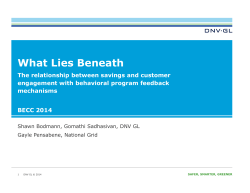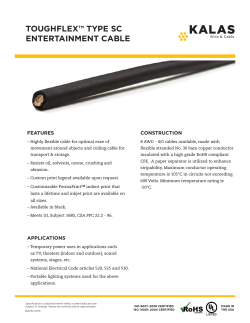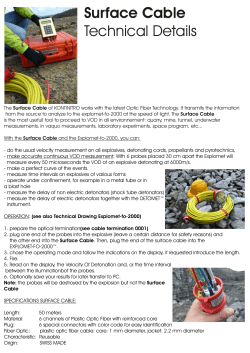
A joined industry project towards verification and certification
A joined industry project towards verification and certification of submarine power cables Advanced submarine power cable & interconnection forum, Berlin Wessel Bakker and Frank de Wild 18 June 2014 1 DNV GL © 2013 18 June 2014 SAFER, SMARTER, GREENER Agenda Today’s QA/QC and innovation by Wessel Bakker – Introduction to DNV GL – Cable life cycle – Innovation in cable technology – Product and project certification Joint Industry Project by Frank de Wild – Background – Consultant view – Certification view – Higher goal for the Joint Industry Project – Description of JIP – Invitation to potential participants at this workshop – Q&A 2 DNV GL © 2013 18 June 2014 Introduction Wessel Bakker Currently 4 years at DNV GL (former KEMA), Head of Department in Power System Planning and Project Management & Technical Services, advisory services in – strengthening of grids, – balancing of electrical power supply & demand, – integration of renewables – offshore T&D technologies. 20 years at ABB in Power Generation and Transmission & Distribution as electrical engineer, project manager of electrical balance of plant, sales manager, senior account manager of major utilities and manager of strategy of ABB Benelux. President of the Dutch National Committee of CIGRE. Delft Technical University, MSc. Electrical Engineering. DNV GL © 2013 18 June 2014 We are a global classification, certification, technical assurance and advisory company 4 DNV GL © 2013 18 June 2014 In a challenging world we make businesses better prepared Low carbon energy Short-term cost efficiency Complexity and lack of global governance Reliable and affordable energy Long-term competitiveness Trust and transparency DNV GL © 2013 18 June 2014 Efficient and fast Safe This takes detailed knowledge and diverse domain competence 6 • Technical and operational challenges… • Regulatory processes… • Value chain interdependencies… • Stakeholder considerations… DNV GL © 2013 18 June 2014 Only by connecting the details can we impact the bigger picture • We classify, certify, verify and test against regulatory requirements, rules, standards and recommended practices • We develop new standards and recommended practices • We qualify new technologies and operational concepts • We give expert advice to enhance sustainable business performance 7 DNV GL © 2013 7 18 June 2014 We call it the broader view 8 • Reducing uncertainty, increasing safety • Improving efficiency • Enabling sustainability • Building trust DNV GL © 2013 18 June 2014 SAFER, SMARTER, GREENER Industry consolidation 9 DNV GL © 2013 18 June 2014 Global reach – local competence 150 400 100 16,000 years offices countries employees 10 DNV GL © 2013 18 June 2014 Organized to maximize customer value MARITIME OIL & GAS ENERGY SOFTWARE CYBERNETICS RESEARCH & INNOVATION 11 DNV GL © 2013 18 June 2014 BUSINESS ASSURANCE Cable life cycle value chain DNV GL © 2013 18 June 2014 Cable life cycle value chain Feasibility studies System studies and Basic design Decommissioning Failure analysis Tender evaluation Production and testing Diagnostics Installation Operation & Maintenance DNV GL © 2013 18 June 2014 13 Submarine cable references examples Submarine interconnector projects (different roles): – NO-NL, UK-NL, UK-IR, UK-Northern Ireland, DK-NL, BE-UK, UK-UK, Caribbean interconnector, Far East interconnector, 2 more strictly confidential interconnectors – AC and DC cables, extruded and mass impregnated Windfarm export cable / collector cable / offshore facility cable projects: – Belgium, Netherlands, UK, Germany, Norway, Middle East – AC and DC cables, single core and three core cables Submarine cable conceptual studies – Studies towards networks at sea, options to connect off shore windfarms to existing grids – Several feasibility studies for exceptional interconnectors (strictly confidential) Role of DNV KEMA: – Feasibility studies, conceptual design studies, technical problem solving, innovations – Independent QA/QC over complete project, risk mitigation – Safety studies – Failure investigations DNV GL © 2013 18 June 2014 14 Innovations in cable technology DNV GL © 2013 18 June 2014 Committed to innovation and foresight DNV GL invests 5% of revenue in research & innovation every year, we collaborate with industry partners and external experts, we share knowledge through standards and recommended practices. we provide foresight and initiate competence building and innovation we provide specific cable innovation projects – Extraordinary innovation projects – Subsea Cable Repair – Floating Cable – Innovation Projects – Dynamic Rating System – Cable cover thickness monitoring – Joined Industry Projects – Smart Cable Guard – Recommended practice for subsea power cables in shallow water DNV GL © 2013 18 June 2014 17 Extra Ordinary Innovation Project: Subsea Cable Repair 18 DNV GL © 2013 18 June 2014 Extra Ordinary Innovation Project: Floating Cable Concept Copyright: Per Sverre Wold-Hansen / Softedge DNV GL © 2013 18 June 2014 19 Innovation Project: Example: Dynamic rating system Typical current as function of time for an off-shore windfarm export cable Conclusion: – Significant thermal inertness of cable and environment present – Leading to significant room for more current transport, estimated on average 20% to 35% more current transport during peaks of 24 hrs in length DNV GL © 2013 18 June 2014 20 Innovation project: Example: Cable cover thickness monitoring In case of reduced sand cover over a power cable, risk on failure due to fishing gear, anchoring, vibration (if exposed cable in free span) and third party activities Options to monitor exposed power cable – Regular check with ship logging (sonar) – known, but how often to be done? – On-line monitoring with fiber optics – Check temperature variations with cable loading with model of cable environment, and determine thermal capacitance and resistance – Deduce amount of soil around power cable from this DNV GL © 2013 18 June 2014 21 Joint Industry Project Example: Qualification of Offshore HVDC technology Qualification of Offshore HVDC technology – 11 partners, offshore as well as onshore background, and different practices – Result of JIP formulated in a Recommended Practice – An RP provides an efficient tool to document Best Practice in an area where technology changes, and no international standards are yet available 22 DNV GL © 2013 18 June 2014 Joint Industry Project Example: Smart Cable Guard Smart Cable Guard (SCG) is a new patented DNV GL award winning ON-LINE monitoring tool for MV power cables that (with 1 % location accuracy) – Locates weak spots to prevents outages (Operator can remove weak spots) – Locates failures to reduces outage times (Operator can perform a faster repair) Use up to 36kV (array cable) Developed together with 3 partners with DNO background SCG equipment 23 DNV GL © 2013 18 June 2014 SCG sparks from weak spot and risk warning Defect found at weak spot – failure avoided February 2014: New recommended practice for subsea power cables in shallow water renewable energy applications released Reason for proposal Disproportional insurance claims related to cables within offshore wind farms. Lack of “best practice”, especially for cable system design and installation. Industry interest to work with DNV on new guideline (JIP, 15 participants, August 2012 – autumn 2013). Scope of the proposal RP was developed in a style which will allow future updates, expansions and conversion into a standard. Consequences A comprehensive guideline freely available to the industry. A communication tool for all stakeholders. A building block for 3rd party verification, complementing DNV wind turbine and offshore substation guidelines. 24 DNV GL © 2013 18 June 2014 Product and project certification DNV GL © 2013 18 June 2014 High voltage cable testing Independent testing and certification of medium, high and ultra-high voltage components used in transmission and distribution power networks Largest commercially operated High Voltage Laboratory in the world Specialized in high voltage AC and HVDC cable testing Test bays for PQ tests Various trailers for on-site commissioning testing World renowned and fully accredited laboratories, largest short circuit laboratory in the world Tests are based on internationally accepted standards (like IEC and IEEE) Extreme testing capacity in development for ultra-high power equipment (1200kV) for super grids KEMA Type Test Certificate, Report of Performance 26 DNV GL © 2013 18 June 2014 High power testing Independent testing and certification of medium, high and ultra-high voltage components used in transmission and distribution power networks No. 1 and largest High Power Laboratory in the world Largest High Power Laboratory in the Americas EUR 70 million investment for extreme 800 kV testing market Up to 1200 kV circuit breaker testing Unique testing method for large power transformers Complete type test of LV assemblies High Power Test Laboratories located in Arnhem, Prague and Chalfont Fully accredited Laboratories KEMA Type Test Certificate, Report of Performance 27 DNV GL © 2013 18 June 2014 Project certification Modular service provision for onshore and offshore wind projects based on client’s needs Site specific design conditions Site specific design assessment Surveillance during production Surveillance of transport and erection Surveillance during commissioning Project certificate Periodic monitoring Longest history in wind energy Certification is based upon: Own standards/guidelines International standards Biggest workforce and highly qualified teams Various national certification systems Avoiding damages/reducing financial risks/securing investment DNV standards and GL guidelines 28 DNV GL © 2013 18 June 2014 Customer’s specifications Renewables certification Accredited certification of equipment (products), services and projects in renewable energy Component certification Prototype certification Type certification Project certification Onshore wind Certification is based upon: Offshore wind Internationally accepted standards Wave and tidal Various national certification systems Solar/PV DNV standards and GL guidelines 29 DNV GL © 2013 18 June 2014 A joint industry project towards verification and certification of submarine power cables Advanced submarine power cable & interconnection forum, Berlin - Germany Wessel Bakker and Frank de Wild 18 June 2014 30 DNV GL © 2013 18 June 2014 SAFER, SMARTER, GREENER Who am I? Frank de Wild • 16 yrs with DNV GL (legacy KEMA) • Principal consultant • Leading DNV GL Power cable team in Energy Advisory • (pre-)design, feasibility, QA/QC, engineering aspects, safety, etc. • HVAC and HVDC cables • Land and submarine cables • Emphasis on current ratings (ampacity) Active in Cigre SC B1: • as national member of SC B1 • as convenor of WG B1.35 – current rating • as convenor of TF B1.53 – cable installation related damage 31 DNV GL © 2013 18 June 2014 Contents Introduction Background – Consultant view – Failure investigations – Quality assessment / quality control – Standards and guidelines – Certification view Higher goal for the Joint Industry Project Description of JIP Invitation to participate Q&A 32 DNV GL © 2013 18 June 2014 Views from our consultants 33 DNV GL © 2013 18 June 2014 Developments around submarine power cables Number of large cable projects is rising Submarine cables to wind farms Submarine cables to offshore facilities Submarine cable connectors to offshore hubs Submarine interconnectors between countries Demands are increasing Cable failure leads to outage of the facility, and has important impact Loading, RAM, EMF requirements are on the rise Complexity of solutions is increasing 34 DNV GL © 2013 18 June 2014 Information from failure investigations ‘Failures’ in submarine cables from DNV GL experience: We see many failures happening before and after commissioning. Almost all cable parts are affected, and cable handling is very important Various cable systems fail to meet specs before service starts During service, cables failures are not uncommon – External (anchoring, damage) – Internal (e.g. insulation failures) When a failure happens: During service: Repair can be time consuming due to difficulty to pinpointing failure & repair failure During testing: Assessment can lead to redesigning or significant retesting of the cable system, leading to important project consequences 35 DNV GL © 2013 18 June 2014 Information from failure investigations Benefit from failures: Application of learning cycle – Failures enable us to learn what is important – The way back to acceptable situations is defined, often involving special manufacturing, installation, testing or control procedures – Further discussions lead the way how to mitigate these failures in the first place – This information can be used in early phases of other projects 36 DNV GL © 2013 18 June 2014 Cable life cycle value chain Feasibility studies System studies and Basic design Decommissioning Failure analysis Tender evaluation Production Diagnostics Installation Operation & Maintenance DNV GL © 2013 18 June 2014 37 Information from QA/QC projects Quality management in projects To prevent problems, DNV GL proposes to include contentwise QA/QC in large cable projects from the starting phase to the commissioning phase We do so as a service to the power cable market Quality management: 1. Definition of the required level of quality 2. Quality Assurance – the process to measure and assure this level 3. Quality Control – Verification whether the quality is according to the defined quality level 38 DNV GL © 2013 18 June 2014 Quality control during first project stages Project stage QA/QC measure Project specification Review on contents, consistency and completeness Prequalification of supplier ISO 9001 audit Assessment of standard work procedures Assessment of supplier’s experience Tender documentation Definition of set of functional requirements (FR) Definition of responsibilities for functional requirements, definition of situation when problems are encountered 39 DNV GL © 2013 18 June 2014 Quality control during project Project stage Quality control measure Tendering stage Bid evaluation on contents, check if FR can be met Engineering phase Design review Solving design issues Check if FR are met Manufacturing phase Review of test and inspection plans Performing tests on assets (also when not part of IEC) Check if FR are tested 40 DNV GL © 2013 18 June 2014 Quality control during project Project stage Quality control measure Realisation phase Review work plans Check if realisation is performed according to work plans Check if FR are being met Commissioning phase 41 DNV GL © 2013 18 June 2014 Check if FR can be demonstrably met Quality control during project Some important insights: Quality levels are defined in the early stages of projects and are affected by the choices made there. Control actions are especially important in these early project stages to avoid problems later Quality control is about implementing checks (Plan-Do-Check-Act cycle). Most importantly the functional requirements should be checked Actual component testing is a part of quality control, but quality control is much wider Standardized testing is always based on a compromise and is consequently appropriate for improvement or for additional quality control measures For adequate quality control in a project, in-depth technical insight is mandatory It would be best to have a single, knowledgeable party performing the quality control from project start to project finish 42 DNV GL © 2013 18 June 2014 DNV GL experience from QA/QC projects Specifications are often not 100% complete or fully adequate E.g. RAM analysis missing, no definition of optical fibre cable properties, no definition of traceability of materials, installation requirements incomplete or unverified, tests missing Not too much attention to technical risk management and mitigation processes Agreements between contract parties give room for uncertain project continuation in case of failures Quality control not always performed, end-client not verifying ITP and QC actions Relation between burial depth and failure probability is much more complicated than e.g. current BPI theory, representative depth measurements are very difficult Problems arise with meeting the functional requirements (specification) of a project 43 DNV GL © 2013 18 June 2014 Experience with existing standards and guidelines Available standards, guidelines form a good basis IEC 60840, 62067 “Test methods for power cables, but not specifically for submarine cables” Cigre TB 490 “Recommendations for testing of long AC submarine cables with extruded insulation” However, ‘unclarities’ exist, e.g. Development tests are required for special topics for each project, but these are not often specified / required / communicated FO missing in TB 490, interaction between power cable cores and fibre optic cable is not described nor tested Material definition is rather vague: – In case of changes, cables must have ‘same or similar construction’, and tests must be repeated if it is likely that a ‘significant effect’ is to be expected 44 DNV GL © 2013 18 June 2014 Existing standards and guidelines Uncertainties are partly being addressed Cigre TB 303 “Revision of qualification procedures for HV and EHC AC extruded underground cable systems” Containing a listing of tests currently missing in IEC 60840/62067 (about 30), primarily with focus on electrical behaviour of underground cables, to the choice of the user DNV RP DNV-RP-J301 “Subsea power cables in shallow water renewable energy applications” Containing a set of guidelines predominantly on installation of power cables for offshore windfarms 45 DNV GL © 2013 18 June 2014 Remaining unclarities – consultant’s viewpoint What should be inside and outside specifications? What should be inside an ITP? – What tests should be done additional to IEC standards? – What tests and verification procedures must be applied to FO cables being part of submarine cables? What quality control procedures and verifications should be performed to design, manufacturing, transportation and installation? How to verify that materials which are tested, are actually used in the cable system delivered, and how to ensure that materials remain traceable through the manufacturing and installation procedures How to verify the risk profile of cable system after installation (risk vss burial depth)? 46 DNV GL © 2013 18 June 2014 View from our certifiers 47 DNV GL © 2013 18 June 2014 Offshore Wind in the German North and Baltic Sea Project Certification Certification required by authorities (Federal Maritime and Hydrographic Agency (BSH) according to “Standard Design of Offshore Wind Turbines”, BSH no. 7005, Version 2007 Submarine cables addressed in section 3.4 often applied in combination with exemplarily given GL Rules and Guidelines – IV Industrial Services – Part 2 – Guideline for the Certification of Offshore Wind Turbines, Edition 2012 Submarine cables roughly covered by section 8.10 48 DNV GL © 2013 Private and confidential 18 June 2014 Offshore Wind in the German North and Baltic Sea Project Certification Current certification, test and inspection requirements Power core and accessory design / testing according to IEC 60502 or IEC 60840 Submarine cable type testing according to CIGRE TB490 (mechanical and electrical testing) Current carrying capacity calculation acc. to IEC 60287 in consideration of installation / risers Verification of ITP (Inspection and Test Plan) 49 DNV GL © 2013 Private and confidential 18 June 2014 Offshore Wind in the German North and Baltic Sea Project Certification Current certification, test and inspection requirements Evaluation of cable route survey (locate obstacles, water depth, seabed characteristics) Riser and mechanical protection Installation and fixation up to termination Thermal conductivity of soil (BSH 2K-Criteria) 50 DNV GL © 2013 Private and confidential 18 June 2014 Offshore Wind in the German North and Baltic Sea Project Certification Summary -> Lack of definite requirements with regard to product quality assurance -> Interfaces between owner, suppliers and contractors are not adressed and shall be monitored by third party verification -> No standard available dealing with sea operations and standardized / comparable calculation of forces applied to cables during repair, installation and pull-in -> No standard available dealing with the application and qualification of cable protection systems 51 DNV GL © 2013 18 June 2014 Higher goal 52 DNV GL © 2013 18 June 2014 Higher goal To come to an objective and clear reference to define and measure the quality of an installed submarine power cable To improve the quality, and to reduce the chance of failure of the end product: an installed submarine power cable fulfilling its functional requirements To create clarity on how to define and verify the quality of a submarine power cable To create a reference 53 DNV GL © 2013 18 June 2014 Joint Industry Project 54 DNV GL © 2013 18 June 2014 Description of Joint Industry Project Title Improving cable quality to reduce risk in offshore projects Aim To reduce risks in new offshore cable projects By Defining reference criteria, testing verification and certification procedures for submarine cable projects from definition to commissioning It provides the means to objectively measure the quality of a submarine power cable project. With that, quality can be monitored and improved, and risks can be reduced Yielding a solid basis for verification and future certification of submarine power cables, bringing definable quality, clarity and transparency 55 DNV GL © 2013 18 June 2014 Description of Joint Industry Project Goal to be reached together via a collaborative effort Frequent meetings and subject oriented discussions Limited project duration Ending with a final document, publicly available We currently seek 10-15 participating companies representing different fields in the industry – Willing to actively contribute to this process – Willing to pay the participation fee – Available in October 2014 for the launch meeting of the JIP DNV GL invites you to joint his initiative! Interested? 56 DNV GL © 2013 Please contact Frank.dewild@dnvgl.com 18 June 2014 Q&A 57 DNV GL © 2013 18 June 2014 Questions and answers We believe many failures and project problems can be prevented by creating a good set of reference criteria for the various phases within submarine cable projects. Projects will run smoother with it, risks during the project and during operation will be reduced. It is better to work towards a set of reference criteria together, than to continue without it. Do you agree or not? 58 DNV GL © 2013 18 June 2014 Questions and answers We currently propose to focus on the complete process from project definition to commissioning. It enables to balance various criteria in various stages, but it is a rather large job Is this there a better way forward? 59 DNV GL © 2013 18 June 2014 Questions and answers 60 DNV GL © 2013 18 June 2014 Thank you for your attention and we look forward to collaborate with you! Wessel.bakker@dnvgl.com Frank.dewild@dnvgl.com +31 26 356 2854 www.dnvgl.com SAFER, SMARTER, GREENER 61 DNV GL © 2013 18 June 2014
© Copyright 2025











